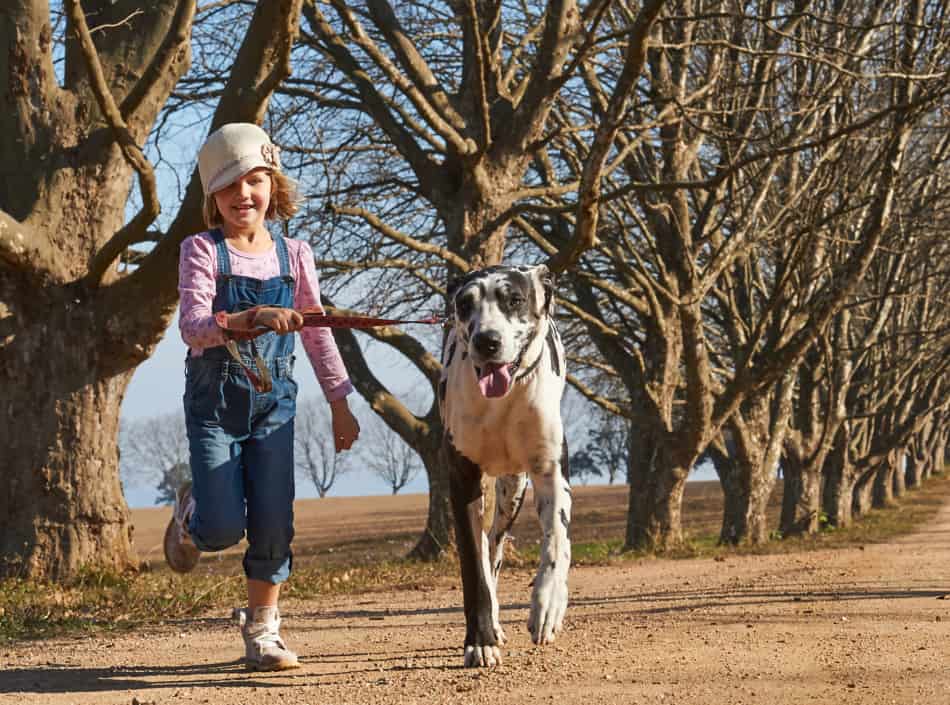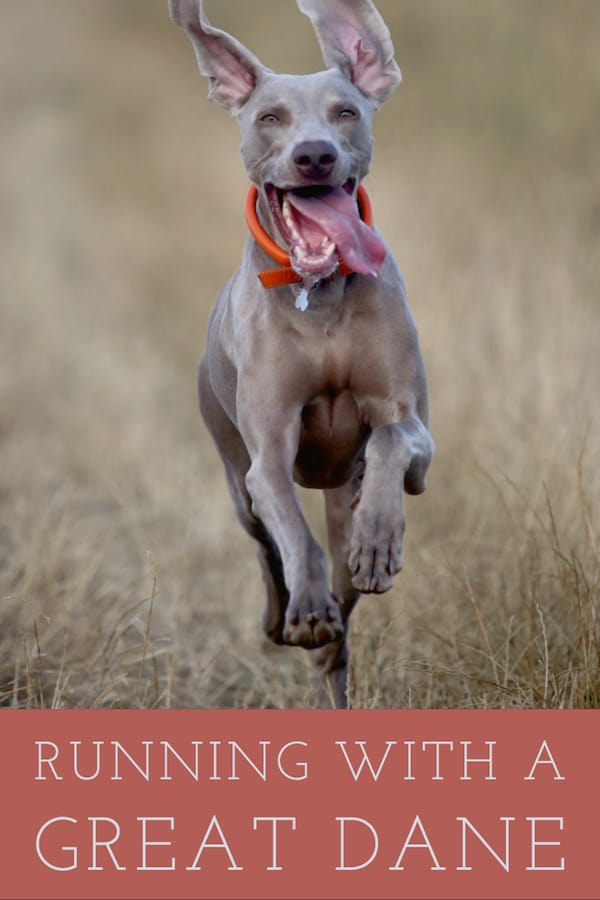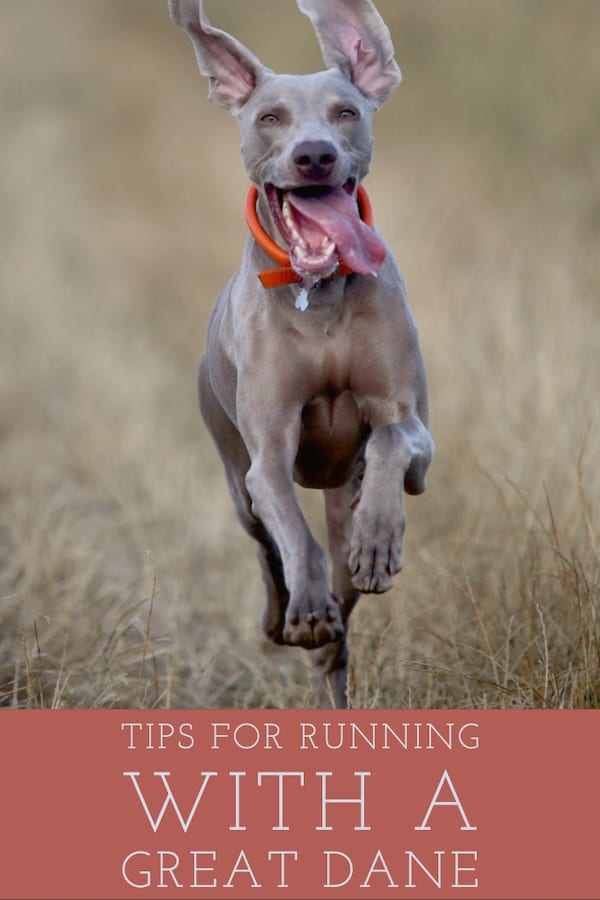
Discover the dos and don’ts of running with your Great Dane to ensure a safe and enjoyable workout for both of you. This article offers expert advice on how to turn your Great Dane into the perfect running companion.
Table of Contents
Great Dane Age
Because they grow so rapidly as puppies, you should avoid having them run with you on a leash until they are 18 months old. Doing so earlier could risk damage to their joints, and lead to orthopedic issues later in life. These issues are often very expensive (thousands of dollars) and can be very painful for the animal.
This is not to say that they shouldn’t run at all, just that you shouldn’t force them to run on a leash until they reach an appropriate age. Running for play in open areas off-leash is fine and actually recommended to help them develop muscle tone.
Note that walking on a leash is also okay as it is a much lower-impact form of exercise. Keep walks in the 5-15 minute range for Danes under 6 months of age. For Danes in the 6-12 month range, you can work up to one-hour walks while slowly increasing distance and time.
Even at one year of age, many Great Danes will be content with a twenty-minute walk. So don’t feel like you need to stretch out the duration to a full hour on every walk.
Distance
Your Great Dane will need time to adapt to the activity of running with you on a leash. This includes both the mental aspect of being a good running buddy, as well as the physical recovery side.
Rather than trying to jump straight into multi-mile runs, start off using a run-walk cadence. For example – run 100 yards, walk 200 yards, run 100 yards, walk 200 yards, etc…
This allows them to get used to running by your side rather than running freely unrestricted.
If they do well with the short run-walk intervals, slowly increase the distance of the run portion until they have mastered running by your side.
Aim to keep the total mileage under a mile for the first couple of runs to ease them into the activity. As they show confidence and endurance with running, you can slowly increase the total distance and remove the walk intervals.
While they may be physically capable of going further, 3 miles is the longest distance we like to take our Danes running. The balance of healthy exercise versus orthopedic wear and tear is a fine line and not one that we like to push with this giant breed.
However, walking or hiking distances can be longer as they are not as high impact.
Frequency
Much like distance, how often your Great Dane is taken on runs should also be taken into consideration. Start with one day per week and slowly increase the number of runs per week (if desired).
If increasing the frequency is desired, a conservative approach could be to add one additional day per week each month. For example, 1 run/week in January, 2 runs/week in February, 3 runs/week in March, etc…
Running frequency should also be considered when including free-form running activities like playing at the dog park or running in other open areas.
If you frequently take your dog to places like this where they get in extra running then you’ll want to increase their runs with you at an even slower rate. Avoid having them both run and engage in heavy play e.g. dog parks on the same day.
Surface Selection
While this option isn’t always available, it’s worth keeping in mind the surface that you and your Great Dane are running on does make a difference.
Harder surfaces such as concrete have a higher impact on both you and your dog’s joints. This creates more wear and tear on your body and increases the chances of future injury.
If they are available, surfaces such as dirt trails and grass are softer and will lower the chance of overuse injuries.
Parks and golf courses are two common examples of areas where you and your Great Dane can enjoy dirt or grass running. However, you’ll still want to check in advance to ensure that you’re both allowed to run there.
Make sure to abide by any local rules such as permits, and dogs being allowed, and make sure to pick up any waste i.e. bring your poop bags!
The other benefit of running on dirt trails or grassy areas is that they often have less pollution. Not being in close proximity to roads, running vehicles, etc… means that they likely have fewer solutions and offer more solitude than more developed areas.
Weather
This shouldn’t come as a surprise, but Great Danes aren’t the best with hot weather. For extremely hot days it’s probably best to avoid running with them on leash altogether. At a minimum, consider shortening the run’s planned length.
For hot days when you do decide to run, try to plan routes where they won’t be exposed to direct sunlight for the full duration. Take advantage of shady areas to give them a few minutes break to cool down and recover.
If available, provide them with small amounts of water but don’t let them gulp down large amounts at once.
If your Great Dane starts to appear lethargic and unwilling to finish the run, has sunken dry-looking eyes, or dry nose and gums then they may be experiencing dehydration and the run needs to be immediately ended.
Get them back home into a cool, shaded area with water available. Serious cases of dehydration may even require medical attention, but if you’re staying within our running guidelines then this shouldn’t be an issue.
Last but not least, watch out for hot surfaces! Pavement and concrete in direct sunlight can get very hot and burn your Dane’s paw pads. If the surface would be too hot for you to run on barefoot, then it’s probably too hot for your Dane to safely run on as well.
Heel / Leash Training
If you’re considering taking your Great Dane on runs with you then we hope that you’ve already gotten them to a very good point with leash training.
They should be trained to stay at your side in the heel position, and follow turns, about faces, etc… with the slightest of command.
Tripping over each other or getting pulled toward other dogs will not make for a pleasant running experience for dogs or humans.
During the initial phases of run training, it may also be beneficial to have them stop and sit next to you while passing others.
This includes both dogs and people as it’s much easier to get pulled off balance while running compared to standing if they were to lunge and pull you.
Advanced Commands
As you and your Great Dane become more experienced with running together, you can make running more enjoyable by teaching them a few additional commands.
Rather than needing to use manual leash direction for hard turns, you can start teaching them commands for “left” and “right”.
Directional leash tugs can also be quite awkward while running so a more convenient option will go a long way. This is very helpful when sharp 90+ degree turns, where even a dog following in a close heel will have a hard time not making some contact with you during the turn.
By including a directional command of “left” or “right” you give them a slight heads-up that one of these hard turns is coming. Simply state the command at the time you provide the leash direction i.e. gentle tug left or right.
Before you know it, they’ll soon learn that these verbal commands equate to the directional leash tug. Once this happens you can switch to voice-only command.
Once you master directional training you can even consider biked walks. However, as with anything, take baby steps and ease into it!


